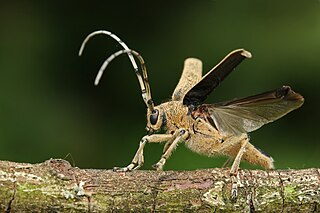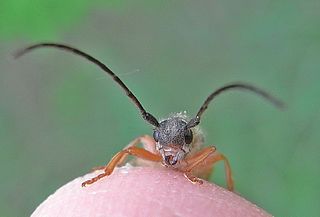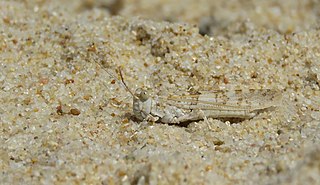
The spot-crowned euphonia is a species of bird in the family Fringillidae. It is found in Costa Rica and Panama. Its natural habitats are subtropical or tropical moist lowland forest and heavily degraded former forest.

Saperda punctata is a beetle species of flat-faced longhorns belonging to the family Cerambycidae, subfamily Lamiinae.

Saperda carcharias is a species of longhorn beetle.

Saperda is a genus of flat-faced longhorn beetles belonging to the family Cerambycidae, subfamily Lamiinae. The genus was erected by Johan Christian Fabricius in 1775.

Saperdini is a tribe of longhorn beetles of the subfamily Lamiinae.

Oberea euphorbiae is a species of beetle in the family Cerambycidae. It was described by Ernst Friedrich Germar in 1813 originally under the genus Saperda. It has a wide distribution in Europe. It feeds on Euphorbia palustris.

The Poplar Borer is a species of beetle in the family Cerambycidae. It was described by Thomas Say in 1824. It is known from Canada and the United States. It contains the varietas Saperda calcarata var. adspersa.
Saperda inornata is a species of beetle in the family Cerambycidae. It was described by Thomas Say in 1824. It is known from Canada and the United States. It feeds on Populus tremuloides.

Saperda alberti is a species of beetle in the family Cerambycidae. It was described by Nikolay Nikolaevich Plavilstshchikov in 1916. It is known from Japan, North Korea, China, Mongolia, and Russia.
Saperda fayi is a species of beetle in the family Cerambycidae. It was described by Bland in 1863. It is known from Canada and the United States.
Saperda florissantensis is an extinct species of beetle in the family Cerambycidae, that existed in what is now the United States during the Miocene. It was described by Wickham in 1916.
Saperda interrupta is a species of beetle in the family Cerambycidae. It was described by Gebler in 1825. It is known from China, Russia, Siberia, Korea and Japan. It is associated with coniferous plantations, and infests species of fir, pine, spruce and other conifers.
Saperda lateralis is a species of beetle in the family Cerambycidae. It was described by Johan Christian Fabricius in 1775. It is known from Canada and the United States.

Saperda perforata is a species of beetle in the family Cerambycidae. It was described by Pallas in 1773, originally under the genus Cerambyx. It has a wide distribution in Europe. It feeds on Populus nigra, Populus alba, and Populus tremula. It is preyed upon by the parasitoid wasp Xorides indicatorius.

Saperda populnea, the small poplar borer, is a species of beetle in the family Cerambycidae which forms woody galls on twigs of poplars and willows. It was described by Carl Linnaeus in 1758.

Saperda scalaris is a species of beetle in the family Cerambycidae. It was described by Carl Linnaeus in 1758, originally under the genus Cerambyx. It has a wide distribution in Europe and Asia. It is preyed upon by parasitoid wasp species including Xorides praecatorius and Helcon angustator.
Saperda subobliterata is a species of beetle in the family Cerambycidae. It was described by Maurice Pic in 1910. It is known from China, Japan and Russia.

The elm borer is a species of beetle in the family Cerambycidae. It was described by Olivier in 1795. It is known from Canada and the United States. It feeds on Ulmus rubra and Ulmus americana. It acts as a vector for the fungus Ophiostoma ulmi, and as a host for the parasitoid wasp Cenocoelius saperdae.
Macrothemis imitans, the ivory-striped sylph, is a species of skimmer in the dragonfly family Libellulidae. It is found in Central America, North America, and South America.

Sphingonotus imitans, the Algarve Sand Grasshopper, is a species of band-winged grasshopper in the family Acrididae. It is found on the Iberian Peninsula.












